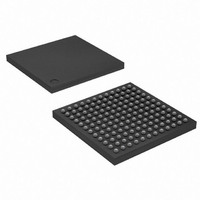AT91SAM9R64-CU Atmel, AT91SAM9R64-CU Datasheet - Page 630

AT91SAM9R64-CU
Manufacturer Part Number
AT91SAM9R64-CU
Description
MCU ARM9 64K SRAM 144-LFBGA
Manufacturer
Atmel
Series
AT91SAMr
Specifications of AT91SAM9R64-CU
Core Processor
ARM9
Core Size
16/32-Bit
Speed
240MHz
Connectivity
EBI/EMI, I²C, MMC, SPI, SSC, UART/USART, USB
Peripherals
AC'97, POR, PWM, WDT
Number Of I /o
49
Program Memory Size
32KB (32K x 8)
Program Memory Type
ROM
Ram Size
72K x 8
Voltage - Supply (vcc/vdd)
1.08 V ~ 1.32 V
Data Converters
A/D 3x10b
Oscillator Type
Internal
Operating Temperature
-40°C ~ 85°C
Package / Case
144-LFBGA
Processor Series
AT91SAMx
Core
ARM926EJ-S
Data Bus Width
32 bit
Data Ram Size
64 KB
Interface Type
2-Wire, SPI, SSC, USART
Maximum Clock Frequency
240 MHz
Number Of Programmable I/os
118
Number Of Timers
4
Maximum Operating Temperature
+ 85 C
Mounting Style
SMD/SMT
3rd Party Development Tools
JTRACE-ARM-2M, MDK-ARM, RL-ARM, ULINK2
Development Tools By Supplier
AT91SAM-ICE, AT91-ISP, AT91SAM9RL-EK
Minimum Operating Temperature
- 40 C
On-chip Adc
10 bit, 3 Channel
Controller Family/series
AT91SAM9xxx
No. Of I/o's
49
Ram Memory Size
64KB
Cpu Speed
240MHz
No. Of Timers
3
Rohs Compliant
Yes
Package
144LFBGA
Device Core
ARM926EJ-S
Family Name
91S
Maximum Speed
240 MHz
Operating Supply Voltage
1.8|3.3 V
For Use With
AT91SAM-ICE - EMULATOR FOR AT91 ARM7/ARM9
Lead Free Status / RoHS Status
Lead free / RoHS Compliant
Eeprom Size
-
Lead Free Status / Rohs Status
Lead free / RoHS Compliant
Available stocks
Company
Part Number
Manufacturer
Quantity
Price
Part Number:
AT91SAM9R64-CU
Manufacturer:
ATMEL/爱特梅尔
Quantity:
20 000
- Current page: 630 of 903
- Download datasheet (13Mb)
38.8
38.8.1
38.8.2
630
SD/SDIO Card Operations
AT91SAM9R64/RL64 Preliminary
SDIO Data Transfer Type
SDIO Interrupts
The MultiMedia Card Interface allows processing of SD Memory (Secure Digital Memory Card)
and SDIO (SD Input Output) Card commands.
SD/SDIO cards are based on the Multi Media Card (MMC) format, but are physically slightly
thicker and feature higher data transfer rates, a lock switch on the side to prevent accidental
overwriting and security features. The physical form factor, pin assignment and data transfer
protocol are forward-compatible with the MultiMedia Card with some additions. SD slots can
actually be used for more than flash memory cards. Devices that support SDIO can use small
devices designed for the SD form factor, such as GPS receivers, Wi-Fi or Bluetooth
modems, barcode readers, IrDA adapters, FM radio tuners, RFID readers, digital cameras and
more.
SD/SDIO is covered by numerous patents and trademarks, and licensing is only available
through the Secure Digital Card Association.
The SD/SDIO Card communication is based on a 9-pin interface (Clock, Command, 4 x Data
and 3 x Power lines). The communication protocol is defined as a part of this specification. The
main difference between the SD/SDIO Card and the MultiMedia Card is the initialization
process.
The SD/SDIO Card Register (MCI_SDCR) allows selection of the Card Slot and the data bus
width.
The SD/SDIO Card bus allows dynamic configuration of the number of data lines. After power
up, by default, the SD/SDIO Card uses only DAT0 for data transfer. After initialization, the host
can change the bus width (number of active data lines).
SDIO cards may transfer data in either a multi-byte (1 to 512 bytes) or an optional block format
(1 to 511 blocks), while the SD memory cards are fixed in the block transfer mode. The TRTYP
field in the MCI Command Register (MCI_CMDR) allows to choose between SDIO Byte or SDIO
Block transfer.
The number of bytes/blocks to transfer is set through the BCNT field in the MCI Block Register
(MCI_BLKR). In SDIO Block mode, the field BLKLEN must be set to the data block size while
this field is not used in SDIO Byte mode.
An SDIO Card can have multiple I/O or combined I/O and memory (called Combo Card). Within
a multi-function SDIO or a Combo card, there are multiple devices (I/O and memory) that share
access to the SD bus. In order to allow the sharing of access to the host among multiple devices,
SDIO and combo cards can implement the optional concept of suspend/resume (Refer to the
SDIO Specification for more details). To send a suspend or a resume command, the host must
set the SDIO Special Command field (IOSPCMD) in the MCI Command Register.
Each function within an SDIO or Combo card may implement interrupts (Refer to the SDIO
Specification for more details). In order to allow the SDIO card to interrupt the host, an interrupt
function is added to a pin on the DAT[1] line to signal the card’s interrupt to the host. An SDIO
interrupt on each slot can be enabled through the MCI Interrupt Enable Register. The SDIO
interrupt is sampled regardless of the currently selected slot.
6289C–ATARM–28-May-09
®
adapters,
Related parts for AT91SAM9R64-CU
Image
Part Number
Description
Manufacturer
Datasheet
Request
R

Part Number:
Description:
MCU, MPU & DSP Development Tools KICKSTART KIT FOR AT91SAM9 PLUS
Manufacturer:
IAR Systems

Part Number:
Description:
DEV KIT FOR AVR/AVR32
Manufacturer:
Atmel
Datasheet:

Part Number:
Description:
INTERVAL AND WIPE/WASH WIPER CONTROL IC WITH DELAY
Manufacturer:
ATMEL Corporation
Datasheet:

Part Number:
Description:
Low-Voltage Voice-Switched IC for Hands-Free Operation
Manufacturer:
ATMEL Corporation
Datasheet:

Part Number:
Description:
MONOLITHIC INTEGRATED FEATUREPHONE CIRCUIT
Manufacturer:
ATMEL Corporation
Datasheet:

Part Number:
Description:
AM-FM Receiver IC U4255BM-M
Manufacturer:
ATMEL Corporation
Datasheet:

Part Number:
Description:
Monolithic Integrated Feature Phone Circuit
Manufacturer:
ATMEL Corporation
Datasheet:

Part Number:
Description:
Multistandard Video-IF and Quasi Parallel Sound Processing
Manufacturer:
ATMEL Corporation
Datasheet:

Part Number:
Description:
High-performance EE PLD
Manufacturer:
ATMEL Corporation
Datasheet:

Part Number:
Description:
8-bit Flash Microcontroller
Manufacturer:
ATMEL Corporation
Datasheet:

Part Number:
Description:
2-Wire Serial EEPROM
Manufacturer:
ATMEL Corporation
Datasheet:











